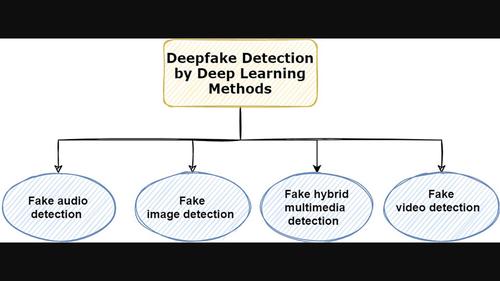当前位置:
X-MOL 学术
›
WIREs Data Mining Knowl. Discov.
›
论文详情
Our official English website, www.x-mol.net, welcomes your
feedback! (Note: you will need to create a separate account there.)
Deepfake detection using deep learning methods: A systematic and comprehensive review
WIREs Data Mining and Knowledge Discovery ( IF 6.4 ) Pub Date : 2023-11-20 , DOI: 10.1002/widm.1520 Arash Heidari, Nima Jafari Navimipour, Hasan Dag, Mehmet Unal
WIREs Data Mining and Knowledge Discovery ( IF 6.4 ) Pub Date : 2023-11-20 , DOI: 10.1002/widm.1520 Arash Heidari, Nima Jafari Navimipour, Hasan Dag, Mehmet Unal

|
Deep Learning (DL) has been effectively utilized in various complicated challenges in healthcare, industry, and academia for various purposes, including thyroid diagnosis, lung nodule recognition, computer vision, large data analytics, and human-level control. Nevertheless, developments in digital technology have been used to produce software that poses a threat to democracy, national security, and confidentiality. Deepfake is one of those DL-powered apps that has lately surfaced. So, deepfake systems can create fake images primarily by replacement of scenes or images, movies, and sounds that humans cannot tell apart from real ones. Various technologies have brought the capacity to change a synthetic speech, image, or video to our fingers. Furthermore, video and image frauds are now so convincing that it is hard to distinguish between false and authentic content with the naked eye. It might result in various issues and ranging from deceiving public opinion to using doctored evidence in a court. For such considerations, it is critical to have technologies that can assist us in discerning reality. This study gives a complete assessment of the literature on deepfake detection strategies using DL-based algorithms. We categorize deepfake detection methods in this work based on their applications, which include video detection, image detection, audio detection, and hybrid multimedia detection. The objective of this paper is to give the reader a better knowledge of (1) how deepfakes are generated and identified, (2) the latest developments and breakthroughs in this realm, (3) weaknesses of existing security methods, and (4) areas requiring more investigation and consideration. The results suggest that the Conventional Neural Networks (CNN) methodology is the most often employed DL method in publications. According to research, the majority of the articles are on the subject of video deepfake detection. The majority of the articles focused on enhancing only one parameter, with the accuracy parameter receiving the most attention.
中文翻译:

使用深度学习方法进行 Deepfake 检测:系统全面的综述
深度学习(DL)已被有效地应用于医疗保健、工业和学术界的各种复杂挑战,用于各种目的,包括甲状腺诊断、肺结节识别、计算机视觉、大数据分析和人类水平的控制。然而,数字技术的发展已被用来生产对民主、国家安全和保密构成威胁的软件。Deepfake 是最近出现的深度学习应用程序之一。因此,深度造假系统主要通过替换人类无法区分的场景或图像、电影和声音来创建虚假图像。各种技术使我们能够用手指改变合成语音、图像或视频。此外,视频和图像欺诈现在非常令人信服,以至于很难用肉眼区分虚假内容和真实内容。它可能会导致各种问题,从欺骗公众舆论到在法庭上使用篡改的证据。出于这些考虑,拥有能够帮助我们辨别现实的技术至关重要。这项研究对使用基于深度学习的算法的深度伪造检测策略的文献进行了完整的评估。我们根据应用对本工作中的 Deepfake 检测方法进行分类,包括视频检测、图像检测、音频检测和混合多媒体检测。本文的目的是让读者更好地了解(1)深度赝品是如何生成和识别的,(2)该领域的最新发展和突破,(3)现有安全方法的弱点,以及(4)领域需要更多的调查和考虑。结果表明,传统神经网络 (CNN) 方法是出版物中最常用的深度学习方法。根据研究,大多数文章都是关于视频深度伪造检测的主题。大多数文章只关注增强一个参数,其中准确度参数最受关注。
更新日期:2023-11-20
中文翻译:

使用深度学习方法进行 Deepfake 检测:系统全面的综述
深度学习(DL)已被有效地应用于医疗保健、工业和学术界的各种复杂挑战,用于各种目的,包括甲状腺诊断、肺结节识别、计算机视觉、大数据分析和人类水平的控制。然而,数字技术的发展已被用来生产对民主、国家安全和保密构成威胁的软件。Deepfake 是最近出现的深度学习应用程序之一。因此,深度造假系统主要通过替换人类无法区分的场景或图像、电影和声音来创建虚假图像。各种技术使我们能够用手指改变合成语音、图像或视频。此外,视频和图像欺诈现在非常令人信服,以至于很难用肉眼区分虚假内容和真实内容。它可能会导致各种问题,从欺骗公众舆论到在法庭上使用篡改的证据。出于这些考虑,拥有能够帮助我们辨别现实的技术至关重要。这项研究对使用基于深度学习的算法的深度伪造检测策略的文献进行了完整的评估。我们根据应用对本工作中的 Deepfake 检测方法进行分类,包括视频检测、图像检测、音频检测和混合多媒体检测。本文的目的是让读者更好地了解(1)深度赝品是如何生成和识别的,(2)该领域的最新发展和突破,(3)现有安全方法的弱点,以及(4)领域需要更多的调查和考虑。结果表明,传统神经网络 (CNN) 方法是出版物中最常用的深度学习方法。根据研究,大多数文章都是关于视频深度伪造检测的主题。大多数文章只关注增强一个参数,其中准确度参数最受关注。


















































 京公网安备 11010802027423号
京公网安备 11010802027423号